Scroll through the lesson and click on notation/video/audio links to load the interactive players.
Please subscribe to get full access to all lessons for only $7.95/month PLUS 1 week free trial.

Riff Interactive lessons are
LESS expensive and
MORE interactive than alternatives!
More Info
|
|
| Lesson Subject:
Blues Legends I |
| What you learn:
Classic Blues Turnarounds |
| Teacher: Michael Johnson |
Michael: This interactive lesson will cover
several classic turnaround licks. A "turnaround" is typically a musical phrase
that plays over the ending or even beginning of a blues progression. These types
of licks are essential to any musician playing the blues. In this lesson you'll
several exercises that will help you add an arsenal of new licks the will help
start you on the path of becoming a great blues player.
Michael:
The turnaround is typically played over the last chord of the progression. In
this case we'll use the key of A. Here's a typical progression in
A:
I (A), IV (D), I (A), V (E), IV (D), I (A), V
(E)
You play the turnaround over the last chord I (A),
notice the phrase actually ends on the V (E) . We'll target starting the
turnaround on the I (A) and resolve the phrase on the V
(E).
I (A), IV (D), I (A), V (E), IV (D), I (A), V
(E)
Teacher: Here's a looping jam track you
can practice the coming turnarounds over. There is a 4 count intro to allow you
to allow you to prepare before practicing your turnaround, you can hear the bass
track resolving on the V (E), unlike the rhythm guitar which comps on the I
(A):
Looping
Turnaround Practice Track
Michael: Turnaround 1 uses a descending line on
the 1st and 3rd strings. This is a classic lick used by many great blues
players.
Michael:
Turnaround 2 uses the same notes but notice the first phrase ascends and the
second phrase descends:
Michael:
Turnaround 1 & 2 are based on chords in A & E, here's the chords they
are based on:
Michael:
The first chord of these patterns show you where the root note is, here's a
picture of the fingering:
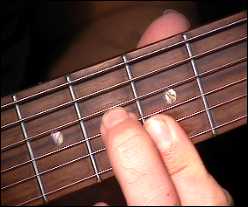
Michael:
The next chords are shaped like a D7
chord, but ascend or descend one half step at a time:
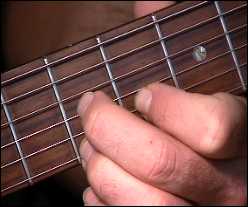
Michael:
Here's the notes are highlighted and then a Dylan style example.
Michael:
A turnaround can also be used to start a song. Jimi Hendrix's "Red House" is a
prime example of using these chords/licks at the beginning of a
song:
Michael:
All you do is pick the chord patterns, this is done in many classic blues songs.
Now you can play single note turnaround lines that basically follow or counter
the bass track. This first turnaround lick doubles the bass
track:
Michael:
notice how the turnaround ascends the I (A) in a chromatic scale pattern, and
then repeats a portion to resolve on the V (E), now you can play Turnaround Lick
1 while you anchor you're 4th finger on the 4th string/7th
fret
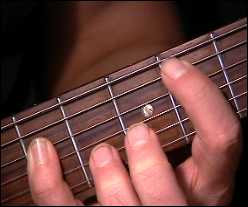
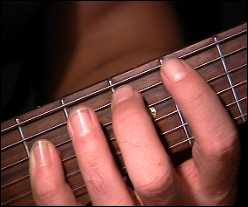
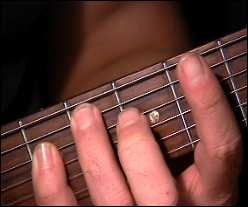
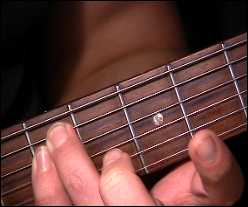
Michael:
Now we can play a counter pattern were
we descend the walking bass line.
Michael:
You can actually combine turnaround licks 2 & 3. This gives you a ascending
and descending line at the same time:
Michael:
I hope you've found these turnarounds to be helpful and something you'll use in
the future. Try your own variations and see what you come up
with. Keep practicing!
|
<< load notation from left
|
|
<< load audio from left
|
<< load audio from left
|